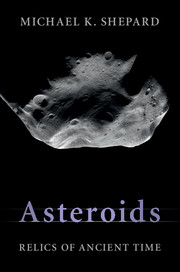Book contents
- Frontmatter
- Dedication
- Contents
- Preface
- Acknowledgements
- Brief list of asteroid and meteorite terms
- 1 It's a small world
- 2 A night at the zoo
- 3 It came from outer space
- 4 A day at the museum
- 5 The gambler's fallacy
- 6 Remembrance of things past
- 7 The ties that bind
- 8 Terra incognita
- 9 To your scattered bodies go
- 10 Scouts, sappers, and miners
- Glossary
- Bibliography
- Index
- References
4 - A day at the museum
Published online by Cambridge University Press: 05 May 2015
- Frontmatter
- Dedication
- Contents
- Preface
- Acknowledgements
- Brief list of asteroid and meteorite terms
- 1 It's a small world
- 2 A night at the zoo
- 3 It came from outer space
- 4 A day at the museum
- 5 The gambler's fallacy
- 6 Remembrance of things past
- 7 The ties that bind
- 8 Terra incognita
- 9 To your scattered bodies go
- 10 Scouts, sappers, and miners
- Glossary
- Bibliography
- Index
- References
Summary
Now art arises when, from many notions gained by experience, one universal judgment about a class of objects is produced.
Aristotle, MetaphysicsHAVILAND, KANSAS
In 1882, Eliza Kimberly, the wife of a local farmer, stumbled across an unusual rock in one of the many fields near Brenham, Kansas. The rock was heavy and appeared to be made of iron, although it showed flashes of embedded green and yellow gems. Ms. Kimberly must have been an interesting woman, for rather than simply leaving it as a curiosity and getting on with the unending work of a farm, she contacted Professor F. W. Cragin of nearby Washburn College in Topeka, who identified it as a meteorite. Soon word got around, and other visitors came, including experts from the American Museum of Natural History. Over the following decades, the site became a mecca for meteorite enthusiasts, including Harvey Nininger (1887–1986) a self-taught collector of meteorites considered to be the “father” of modern meteoritic science. In all, more than a metric ton of what is now known as the Brenham meteorite has been collected.
The Brenham meteorite is a pallasite, like the Krasnoyarsk iron found a century earlier by Peter Pallas. But, unlike the single specimen collected by Pallas, the Brenham keeps popping up – its strewn field covers many square kilometers of real estate over dozens of farms. In November 2005, professional meteorite hunter Steve Arnold, famed for co-hosting the television show Meteorite Men, found another enormous fragment of the Brenham.
Today, more than a century after Ms. Kimberly found the first few fragments, all the surface pieces have been picked up. So on that autumn day, Arnold decided to search in a field near Haviland, about a mile from the original find, and to look deeper. He employed a large custom metal detector, some three to four meters wide, pulled behind an all-terrain vehicle (ATV). The combination of a big detector on an ATV in a wide-open field means a lot of ground can be covered quickly.
- Type
- Chapter
- Information
- AsteroidsRelics of Ancient Time, pp. 97 - 130Publisher: Cambridge University PressPrint publication year: 2015



